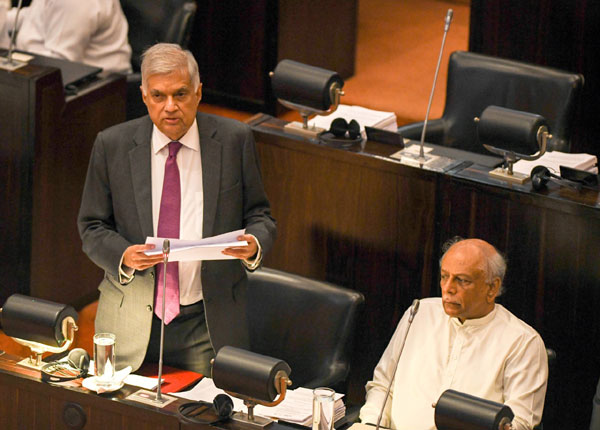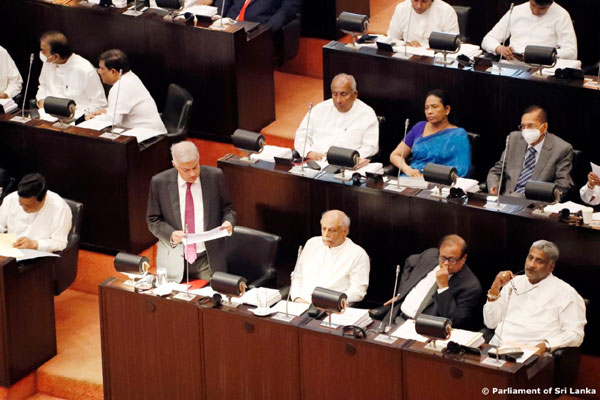President Ranil Wickremesinghe presenting the interim budget in the capacity of the Finance minister today placed a string of short-term and long-term proposals while drawing attention to the low-income groups.
President Wickremesinghe delivering a political message called for support for an all-party government and said the parties had the mandate to change any policies.
Here are highlights from the speech:
*The VAT rate will be increased to 15 percent from the current rate of 12 percent with effect from 1st September 2022.
*Most revenue proposals introduced in May 2022 will be effective from 1st October 2022.
*propose to introduce compulsory tax registration for all residents who are above 18 years of age without considering their annual income and tax-free thresholds.
A comprehensive study of movable and immovable properties, including government owned buildings, lands and vehicles will be conducted with a view to optimise the utilisation and to identify potential real estate for income generating activities.
*As a part of efficient expenditure management, I propose to rationalize the number of government employees. Already, we have allowed those who are willing to take no pay leave for 5 years or so and go abroad or engage in educational activities in the country.
* it is proposed to reduce the retirement age of public sector and semi-governmental employees to 60 years. Those who have been employed beyond 60 years of age at present in the government and semi government sectors will be retired as of 31.12.2022.
*The purchase of fossil fuel-based vehicles for public sector will be suspended from hereafter as a government policy. Only electric-powered vehicles will be purchased for the use of the public sector in the future and the private sector will also be encouraged to use electric vehicles.
*The major fiscal risks arise from a few key SOEs, particularly in the transportation (SriLankan Airlines) and energy sector (CEB and CPC). These entities face significant losses, negative equity (SLA/CPC), and large volumes of debt that is predominantly owed to the state banks, creating significant financial sector risk. it is proposed to establish the “State-Owned Enterprise Restructuring Unit” to facilitate restructuring of government owned business entities.
*Propose to re-activate the Statement of Corporate Intent (SCI) process for key 50 SOEs, excluding CEB, CPC and Sri Lankan Airlines, as they are under different efforts to restructure, to closely monitor the set targets.
* Disposal of scrap materials accumulated in public sector institutions. It is found that a large amount of scrap material are piled up in many government institutions due to non-removal/disposal of the same for a long time. Besides, the government is losing a lot of revenue that could be obtained by selling the scrap material. Accordingly, a committee consisting of three government officials including Comptroller General of the General Treasury, will be appointed to supervise and implement the entire process of the disposal of scrap.
* Establishment of a National Debt Management Agency (NDMA).
* The new Central Bank Act will be implemented as a key legislation to
strengthen the monetary sector in the country. This legislation would provide the framework for effective implementation of inflation targeting and prevent monetary financing of the budget deficit - what is commonly known as money printing.
*Allotment of 20 percent shareholding in state banks to the depositors and staff of those banks
* Allow 20 percent of shareholding of the Bank of Ceylon and People’s Bank by their depositors and staff.
• The Welfare Benefits Act became law in 2002, but it has not properly implemented thus far. The Welfare Benefits Board has now been activated and the data collection to establish the database or the social registry is progressing. A new mechanism for identifying beneficiaries through objective and verifiable criteria has also been established. It will ensure that transparent laws and systems are in place. With the completion of this work, the welfare programmes will be better targeted and cash transfers will be made directly to bank accounts of beneficiaries.
*The government spent additional amount of about Rs. 31,000 million approximately from May to July 2022 to provide an additional monthly allowance as urgent assistance to those who have affected due to loss of employment, decline in agriculture output and inability to cultivate due to many reasons. propose to continue this programme for further four months to reduce the pressure of the economic crisis on the affected people mentioned above.
*Proposed to provide additional monthly allowance of Rs. 2,500 for pregnant mothers in addition to Rs. 20,000 already provided for them.
*It has been reported that there are about 61,000 food insecure families, which need urgent assistance. I will provide Rs. 10,000 per family for a period of further four months.
*The recent increase in the kerosene prices has created difficulties for the owners of small boats which are used for fishing industry and for those who in the plantation areas that has no electricity services. I will provide a subsidy for these areas.
*The monthly Samurdhi allowance has been increased to an amount ranging between Rs. 5,000 to Rs. 7,500 per month for approximately 1.7 million currently Samurdhi receiving families. Apart from that, an assistance of Rs. 5,000 was provided per month temporarily to around 726,000 families who were in the waiting list for expecting Samurdhi benefits.
* Also, the allowance paid for the elderly, disabled, and kidney patients was increased to an amount ranging between Rs. 5,000 to Rs. 7,500. Further, the temporary assistance of Rs. 5,000 was arranged for the people who are in the waiting lists in anticipation of receiving this assistance.
*The number of paddy farmers with 2 hectares or less who are in repayment arrears of cultivation loans given by the state banks as of 31.05.2022 due to the decrease in harvest, lack of fertilizers, agro-chemicals and inputs, abandonment of cultivation, etc., was 28,259. Aimed at strengthening of the farmers and freeing them from debt burden, actions are being taken to write off the outstanding loan amounting to Rs. 688 million (excluding interest) which is currently in default to the state banks. The money to be writing off will be paid back to the respective banks in two years in a phased manner so as not to put added pressure on the cash flow of the General Treasury.
*propose to allocate Rs. 400 million to the Department of Agriculture to produce the necessary seeds and planting materials.
*It is expected that 20 acres of land will be allotted to currently unemployed youth groups (groups of about 10 members) in the area where the identified lands are located for the purpose.
*Food packaging industries using local raw materials should also be promoted to preservation and marketing of agricultural produce.
*special attention should be paid to attract high-end tourists.
*Also, a five-member committee, representing various sectors, should be appointed to present a report focusing on the identification of new places of tourist attractions and the improvement of related facilities and a report.
*Propose to open a branch campus of the Kotalawala Defence University (KDU) in Kurunegala.


Leave Comments